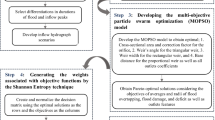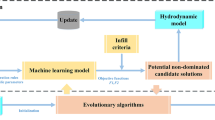Abstract
Cascade reservoir operation is an interactive process in dealing with the floods of the watershed. There are complex hydrological and hydraulic relations between the upstream and downstream reservoirs. However, current reservoir operating rules do not consider cascade reservoir as a system, leaving the impact of release orders on flood control effects unclear. Therefore, this study proposes three types of cascade reservoir operation modes based on different reservoir release orders: sequential impoundment mode (scheme1, 5), reverse-order impoundment mode (scheme2, 3, 6), and alternate impoundment mode (scheme4, 7). Additionally, the joint improved artificial bee colony and K-means clustering algorithms are adopted to classify floods in the basin. The influence of different impoundment and release orders on the effects of flood regulation in the lower reaches of the Jinshajiang River was discussed. The results show that: 1.The alternate impoundment mode is generally applicable to the three typical floods in the lower reaches of the Jinshajiang River. For the third category of large floods that have the worst operating effect, the peak flow reduction rate (PFRR) can reach up to 41.8% for a flood of once-in-100-year return period. 2. The reverse-order impoundment mode has the best scheduling effect on the second category of large floods,the PFRR can reach up to 41.6% for a 100-year flood. 3. The scheme7 presents evident advantages in the joint flood control of cascade reservoir, achieving an average PFRR of 42.8% for a 100-year flood. Furthermore, the implementation of alternate impoundment mode in the cascade reservoir can effectively alleviate flood control pressure on the Chuanjiang River and make a significant contribution to overall flood control efforts within the Yangtze River basin.















Similar content being viewed by others
References
Chen J, Ding Y, Zhang X (2013) Opportunity study of flood control capacity for Three Gorges and Qingjiang cascade reservoirs. Water Resour Power 31:80–82 (in Chinese)
Feng Z, Niu W, Cheng C (2019) China’s large-scale hydropower system: operation characteristics, modeling challenge and dimensionality reduction possibilities. Renew Energy 136:805–818. https://doi.org/10.1016/j.renene.2019.01.059
He Y, Zhou J, Kou P et al (2011) A fuzzy clustering iterative model using chaotic differential evolution algorithm for evaluating flood disaster. Expert Syst Appl 38:10060–10065. https://doi.org/10.1016/j.eswa.2011.02.003
Hu C, Zhang X, Li C et al (2022) Real-time flood classification forecasting based on k-means clustering and neural network. Water Resour Manag 36:103–117. https://doi.org/10.1007/s11269-021-03014-y
Jiang Z, Ji C, Qin H, Feng Z (2018) Multi-stage progressive optimality algorithm and its application in energy storage operation chart optimization of cascade reservoirs. Energy 148:309–323. https://doi.org/10.1016/j.energy.2018.01.176
Karaboga D, Ozturk C (2011) A novel clustering approach: Artificial Bee Colony (ABC) algorithm. Appl Soft Comput 11:652–657. https://doi.org/10.1016/j.asoc.2009.12.025
Karaboga D (2005) An idea based on honey bee swarm for numerical optimization. Dissertation, University of Erciyes
Kim Y-G, Sun B-Q, Kim P et al (2021) A study on optimal operation of gate-controlled reservoir system for flood control based on PSO algorithm combined with rearrangement method of partial solution groups. J Hydrol 593:125783. https://doi.org/10.1016/j.jhydrol.2020.125783
Lian J-J, Guo X-Y, Ma C, Xu K (2019) Optimal reservoir flood control operation using a hedging model and considering the near-field vibrations induced by flood release. Water Resour Manag 33:2645–2663. https://doi.org/10.1007/s11269-019-02231-w
Nagesh Kumar D, Baliarsingh F, Srinivasa Raju K (2010) Optimal reservoir operation for flood control using folded dynamic programming. Water Resour Manag 24:1045–1064. https://doi.org/10.1007/s11269-009-9485-3
Pan Z, Chen L, Teng X (2020) Research on joint flood control operation rule of parallel reservoir group based on aggregation–decomposition method. J Hydrol 590:125479. https://doi.org/10.1016/j.jhydrol.2020.125479
Peng W, Liu B, Liao Y (2018) Flood classification research based on intensity and morphology indexes. J China Hydrol 38:9–13. https://doi.org/10.3969/j.issn.1000-0852.2018.06.002. (in Chinese)
Qi Y, Bao L, Ma X et al (2016) Self-adaptive multi-objective evolutionary algorithm based on decomposition for large-scale problems: a case study on reservoir flood control operation. Inf Sci 367–368:529–549. https://doi.org/10.1016/j.ins.2016.06.005
Qin H, Zhou J, Lu Y et al (2010) Multi-objective cultured differential evolution for generating optimal trade-offs in reservoir flood control operation. Water Resour Manag 24:2611–2632. https://doi.org/10.1007/s11269-009-9570-7
SeethaRam KV (2021) Three level rule curve for optimum operation of a multipurpose reservoir using genetic algorithms. Water Resour Manag 35:353–368. https://doi.org/10.1007/s11269-020-02738-7
Shelokar PS, Jayaraman VK, Kulkarni BD (2004) An ant colony approach for clustering. Anal Chim Acta 509:187–195. https://doi.org/10.1016/j.aca.2003.12.032
Teng J, Jakeman AJ, Vaze J et al (2017) Flood inundation modelling: a review of methods, recent advances and uncertainty analysis. Environ Model Softw 90:201–216. https://doi.org/10.1016/j.envsoft.2017.01.006
Turgeon A (1980) Optimal operation of multireservoir power systems with stochastic inflows. Water Resour Res 16:275–283. https://doi.org/10.1029/WR016i002p00275
van der Merwe DW, Engelbrecht AP (2003) Data clustering using particle swarm optimization. In: The 2003 Congress on Evolutionary Computation, 2003. CEC ’03. IEEE, Canberra, ACT, Australia, pp 215–220
Wang H, Wang X, Lei X et al (2019) The development and prospect of key techniques in the cascade reservoir operation. J Hydraul Eng 50:25–37. https://doi.org/10.13243/j.cnki.slxb.20180795. (in Chinese)
You F, Yu Y, Liu Z et al (2021) Research on flood classification based on joint improved artificial bee colony and k-means clustering algorithms. J China Hydrol 41(4):40–47. https://doi.org/10.19797/j.cnki.1000-0852.20200315. (in Chinese)
Yu Y, Liu Z, Dong P et al (2022) Research on reverse order impoundment mode of cascade reservoir flood control system: case study on upper reaches of Yangtze River. J Hydrol 605:127348. https://doi.org/10.1016/j.jhydrol.2021.127348
Zha G, Zhou J, Yang X et al (2020) Modeling and solving of joint flood control operation of large-scale reservoirs: a case study in the middle and upper Yangtze River in china. Water 13:41. https://doi.org/10.3390/w13010041
Zhang W, Liu P, Chen X et al (2016) Optimal operation of multi-reservoir systems considering time-lags of flood routing. Water Resour Manag 30:523–540. https://doi.org/10.1007/s11269-015-1175-8
Zhang J, Li Z, Wang X et al (2019) A novel method for deriving reservoir operating rules based on flood classification-aggregation-decomposition. J Hydrol 568:722–734. https://doi.org/10.1016/j.jhydrol.2018.10.032
Zhang Y, Chen Q, Xia J (2020) Investigation on flood event variations at space and time scales in the Huaihe River Basin of China using flood behavior classification. J Geogr Sci 30:2053–2075. https://doi.org/10.1007/s11442-020-1827-3
Zhou Y, Guo S, Liu P, Xu C (2014) Joint operation and dynamic control of flood limiting water levels for mixed cascade reservoir systems. J Hydrol 519:248–257. https://doi.org/10.1016/j.jhydrol.2014.07.029
Zhu D, Mei Y, Xu X et al (2021) Optimal operation of a parallel multireservoir system for flood control using a stagewise compensation method. Water Resour Manag 35:1689–1710. https://doi.org/10.1007/s11269-021-02803-9
Acknowledgements
The authors acknowledge the financial support granted the National Natural Science Foundation of China (No.42207084), the Natural Science Basic Research Program of Shaanxi Province (No.2023-JC-QN-0372), the Joint Fund Project of the Natural Science Foundation of Shaanxi Province (No. 2021JLM-54), the Key Research and Development Project of Shaanxi Province (No. 2019SF-237), and the Fundamental Research Funds for the Central Universities, CHD (Nos. 300102291507, 300102269201).
Funding
This work was supported by the National Natural Science Foundation of China [No.42207084], the Natural Science Basic Research Program of Shaanxi Province [No.2023-JC-QN-0372], the Joint Fund Project of the Natural Science Foundation of Shaanxi Province [No. 2021JLM-54], the Key Research and Development Project of Shaanxi Province [No. 2019SF-237], and the Fundamental Research Funds for the Central Universities, CHD [Nos. 300102291507, 300102269201].
Author information
Authors and Affiliations
Contributions
FY: Conceptualization, methodology, writing, investigation, programming, formal analysis, visualization. ZL and ZG: Supervision, touch up language, funding acquisition, reviewing, data curation. YY: Reviewing, formal analysis, programming. YX: Reviewing and programming.
Corresponding author
Ethics declarations
Conflict of interest
The authors have no relevant financial or non-financial interests to disclose.
Additional information
Publisher's Note
Springer Nature remains neutral with regard to jurisdictional claims in published maps and institutional affiliations.
Rights and permissions
Springer Nature or its licensor (e.g. a society or other partner) holds exclusive rights to this article under a publishing agreement with the author(s) or other rightsholder(s); author self-archiving of the accepted manuscript version of this article is solely governed by the terms of such publishing agreement and applicable law.
About this article
Cite this article
You, F., Liu, Z., Guan, Z. et al. Discussion on different impoundment and release orders of huge cascade reservoir system and its effects in the course of flood regulation. Stoch Environ Res Risk Assess 37, 4661–4677 (2023). https://doi.org/10.1007/s00477-023-02532-y
Accepted:
Published:
Issue Date:
DOI: https://doi.org/10.1007/s00477-023-02532-y




